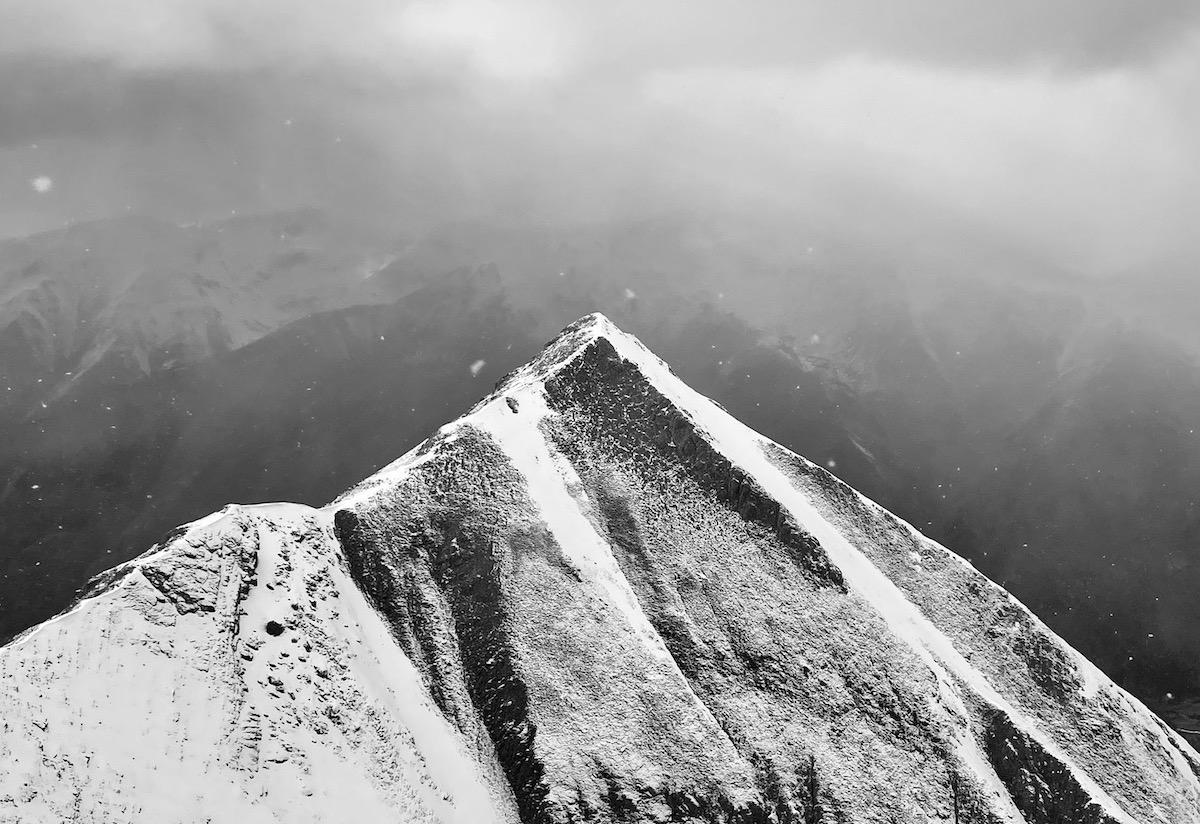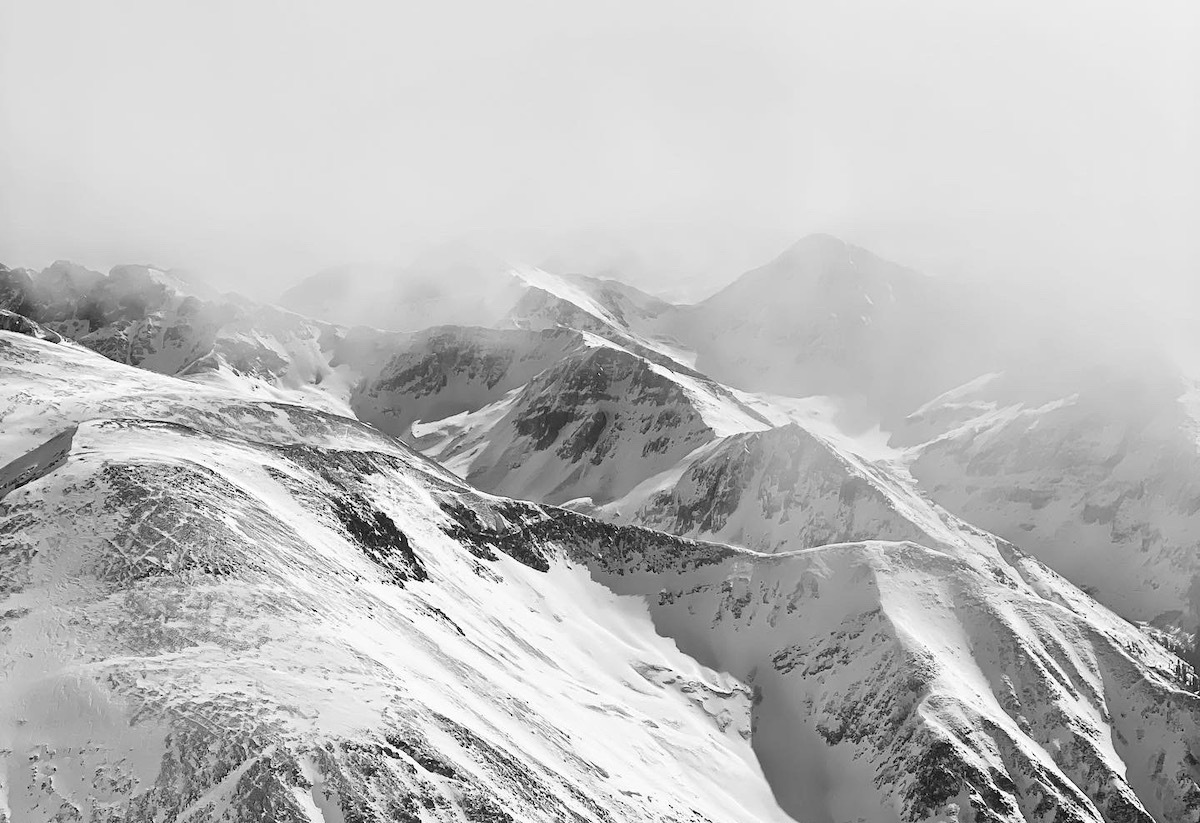The points on my crampons and my hands clinging to the rocks keep me connected to the mountain. I wedge myself between two rocks so I can rest for a minute and decide whether continuing up is a dumb idea.
As visibility decreases and the snow starts accumulating on the crumbly stone, the weather decides for me. Time to get down. Eventually, I hit the dirt road back to my truck, relieved to be on solid ground again. As I jog down, I ask myself why I went up there and continued going up, as the weather deteriorated.
Like a moth to a flame, we stand on the edge of risk and reward. We seek the quiet places and the dark spaces. Racing through the night and across the mountains, we fight hunger and thirst, sleep and sickness, and the thin line between feeling broken and more alive than ever.
Deep exhales across jagged peaks, contentment in exhaustion when we fall asleep at night, and a glimmer of confidence to keep pursuing our dreams … that’s why we are here.
I can’t hide the heartache of the past few months and while my heart isn’t — and may never be completely — healed, I am slowly finding some strength and freedom in the loneliness. Just like the adventures we take in the mountains, I move forward one footstep at time. Endurance, I have discovered, is not just something we practice in sport, but something we will continually practice through all of life’s adversities.
As the sun arcs low across the winter horizon I chase the waning daylight hours. Snow flurries surround me as pockets of blue shift in the clouds and rays of light stream into distant basins. The rocks are slippery, so I move quickly but delicately along the ridge. I stop every few minutes to watch a shifting spotlight of sun across the way.
My dad has told me often that throughout rough times in his life, he repeats the words, “Thank you. Thank you. Thank you.” It’s easy when you’re struggling to focus on what you don’t have or where you’ve fallen short, but he says that expressing gratitude — even if it can be hard to see initially — helps. As the light and snowflakes dance around me I whisper, “Thank you,” into the wind.
Outside of the mountains this past month, I’ve sat around bonfires and dinner tables with friends and family and danced to the wee hours locked arm-in-arm with people I don’t have to explain my struggles to. Much like the mountains, our communities give us the space and time to move through the valleys all while filling our glasses up with gratitude when we need it most. And they, of course, are the heart-warming complement to all the solitude we experience in the hills.
I jog up the road, smooth and even on terrain I don’t have to think about. I reach the ridgeline and veer off the road. The ridge is the route, generally speaking, but what lies between here and the summit are unknown to me.
Approaching the first knoll, I start scrambling up the rocks. I put a foot in the snow next to the rocks to see how deep I’d sink. Deciding it would be faster, I pull on my crampons, take my ice axe out, and boot up. The ridge reveals itself: a puzzle of rocks and snow. I pick my way over, under, around, and through it and eventually meet the couloir to the summit block.
The line my footsteps makes adds a sense of scale to the peaks; my tracks look insignificant and humble against the dramatic walls. The snow starts dumping as I begin the final scramble. I pull a couple of moves as the summit adrenaline takes hold, but then pause.
As I relayed at the start of this article, the mountains around me disappear in the whiteout. All I can see are the snow-covered cliffs below. The adrenaline is wiped out by fear.
I can see the summit and think I could make it, but down-climbing seems questionable in the fresh snow. I pause there, paralyzed by indecision, until my toes and fingers start to go numb. Time to bail.
As I recount this experience, I realize the why. It was curiosity that pulled me forward. I, and I think all endurance athletes, tend to be drawn to things we aren’t sure we can do. As in life, we are constantly tested by the unknowns, and if we can learn to embrace them, then maybe, just maybe, we can learn something.
In his 1988 essay, “The Art of Suffering,” the renowned Polish mountaineer Voytek Kurtyka aptly wrote, “Whenever a climber leaves the known paths, he enters an area without rules or routines to rely on. The only advice comes from deep inside the self, and hopefully the motivation is true. At such moments, the mountaineer is creative, not merely a participant in sport.
“This creativity manifests itself in styles of climbing or in exploration of unknown areas. It is impossible to cram mountaineering into a sport framework. To me there are as many ways to experience the mountains as there are real and passionate emotional bonds with the mountains … I conclude that mystery is essential to mountaineering. What is unveiled to the individual when involved with creative mountaineering forms part of a new bond with the mountain experience.”
Call for Comments
- What unknowns or seemingly impossible tasks are you drawn to?
- How do you show or feel gratitude to the universe when things get difficult?
- Does a good struggle on the trail yield perspective for a struggle in life?





